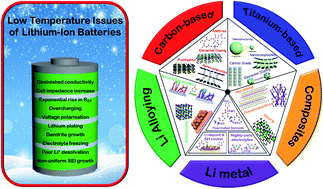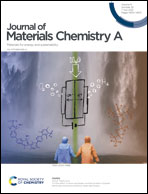Alternative anodes for low temperature lithium-ion batteries
Abstract
Li-ion batteries (LIBs) have become critical components in the manufacture of electric vehicles (EVs) as they offer the best all-round performance compared to competing battery chemistries. However, LIB performance at low temperature (LT) extremes of EV operation (typically −40 to 0 °C) suffers from a reduced output and diminished cycle life. LT cycling increases cell impedance, diminishing Li ion diffusion through the cell, exacerbating electrode polarisation, and hindering interfacial Li+ desolvation. Herein, we present a comprehensive review of (i) the factors that influence LT Li-ion performance, (ii) outline the shortcomings of the current state-of-the-art and (iii) discuss recent findings in the field, focusing on alternative anode materials with particular emphasis on high-capacity, fast charging alternatives to the archetypal carbon (graphite) anode. Different approaches to improve LT LIB performance are outlined in an in-depth analysis of recent improvements from the anode perspective. These include electrolyte-driven enhancements, the resurgence of Li metal batteries, the impact of conductive coatings, elemental doping and nanocomposite formation, substitution of intercalating anodes with high-capacity Li alloying and Li conversion materials, and fast redox pseudocapacitance.



 Please wait while we load your content...
Please wait while we load your content...